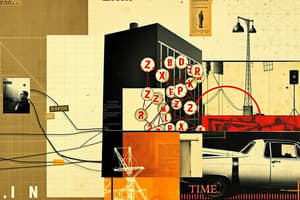Podcast
Questions and Answers
A switch makes forwarding decisions based on which two factors?
A switch makes forwarding decisions based on which two factors?
- Egress interface and source MAC address
- Egress interface and destination MAC address
- Ingress interface and source MAC address
- Ingress interface and destination MAC address (correct)
A switch will forward traffic out the same interface it received the traffic.
A switch will forward traffic out the same interface it received the traffic.
False (B)
What is another name for the MAC address table?
What is another name for the MAC address table?
Content Addressable Memory table
In the store-and-forward switching method, the switch checks the ____________ for errors.
In the store-and-forward switching method, the switch checks the ____________ for errors.
Match the switching method with its description.
Match the switching method with its description.
Which of the following is a characteristic of cut-through switching?
Which of the following is a characteristic of cut-through switching?
In full-duplex mode, collision domains are eliminated.
In full-duplex mode, collision domains are eliminated.
What type of device breaks up a broadcast domain?
What type of device breaks up a broadcast domain?
Switches use the MAC address table and ____________ to eliminate collisions and avoid congestion.
Switches use the MAC address table and ____________ to eliminate collisions and avoid congestion.
Which of the following is NOT a feature of switches that alleviates network congestion?
Which of the following is NOT a feature of switches that alleviates network congestion?
What is the primary function of a Content Addressable Memory (CAM) table in a switch?
What is the primary function of a Content Addressable Memory (CAM) table in a switch?
A collision domain exists in a network segment operating in full-duplex mode.
A collision domain exists in a network segment operating in full-duplex mode.
What is the function of 'auto-negotiation' in network devices?
What is the function of 'auto-negotiation' in network devices?
A switch floods a frame out of all interfaces except the ingress port when the destination MAC address is a ____________ or is unknown.
A switch floods a frame out of all interfaces except the ingress port when the destination MAC address is a ____________ or is unknown.
Match the term with its description.
Match the term with its description.
Which method does Cisco prefer a switch use to make frame forwarding decisions?
Which method does Cisco prefer a switch use to make frame forwarding decisions?
Cut-through switching always performs a full FCS check before forwarding a frame.
Cut-through switching always performs a full FCS check before forwarding a frame.
What is the maximum delay that is acceptable from source to destination when using a voice VLAN?
What is the maximum delay that is acceptable from source to destination when using a voice VLAN?
VLANs are based on ____________ connections
VLANs are based on ____________ connections
Match the terms with their descriptions.
Match the terms with their descriptions.
What benefit is provided by VLANs?
What benefit is provided by VLANs?
VLAN 1 can be deleted or renamed.
VLAN 1 can be deleted or renamed.
On what type of link is the native VLAN used?
On what type of link is the native VLAN used?
All frames are ____________ on an 802.1Q trunk link, except for those on the native VLAN.
All frames are ____________ on an 802.1Q trunk link, except for those on the native VLAN.
Match the VLAN type with its primary purpose.
Match the VLAN type with its primary purpose.
Which of the following is NOT a characteristic of voice VLANs?
Which of the following is NOT a characteristic of voice VLANs?
Without a Layer 3 device, devices in different VLANs can communicate.
Without a Layer 3 device, devices in different VLANs can communicate.
What is the size, in bytes, of the IEEE 802.1Q header?
What is the size, in bytes, of the IEEE 802.1Q header?
A trunk is a point-to-point link between two ____________ devices.
A trunk is a point-to-point link between two ____________ devices.
Match the VLAN trunk term with its description.
Match the VLAN trunk term with its description.
Which of the following is NOT a benefit of VLANs?
Which of the following is NOT a benefit of VLANs?
The VLAN ID (VID) field in an 802.1Q tag is 16 bits long, enabling support for up to 65,536 VLANs.
The VLAN ID (VID) field in an 802.1Q tag is 16 bits long, enabling support for up to 65,536 VLANs.
What command is used to check DTP mode?
What command is used to check DTP mode?
The ____________ range VLANs are used by service providers.
The ____________ range VLANs are used by service providers.
Match the DTP mode with its description.
Match the DTP mode with its description.
By default, what VLAN is the native VLAN?
By default, what VLAN is the native VLAN?
The use of a native VLAN is a modern security protocol.
The use of a native VLAN is a modern security protocol.
What value is used for a 2-Byte VLAN Tag?
What value is used for a 2-Byte VLAN Tag?
DTP is a proprietary protocol from ____________
DTP is a proprietary protocol from ____________
Which of the following commands removes the VLANs from a switch?
Which of the following commands removes the VLANs from a switch?
Flashcards
Ingress
Ingress
Entering the interface
Egress
Egress
Exiting the interface
MAC address table
MAC address table
A table used by switches to make forwarding decisions based on MAC addresses.
Destination MAC address
Destination MAC address
Signup and view all the flashcards
Source MAC address
Source MAC address
Signup and view all the flashcards
Store-and-forward switching
Store-and-forward switching
Signup and view all the flashcards
Error Checking
Error Checking
Signup and view all the flashcards
Buffering
Buffering
Signup and view all the flashcards
Cut-through switching
Cut-through switching
Signup and view all the flashcards
Full Duplex
Full Duplex
Signup and view all the flashcards
Broadcast domain
Broadcast domain
Signup and view all the flashcards
Router
Router
Signup and view all the flashcards
VLAN
VLAN
Signup and view all the flashcards
VLANs
VLANs
Signup and view all the flashcards
Smaller Broadcast Domains
Smaller Broadcast Domains
Signup and view all the flashcards
Improved IT Efficiency
Improved IT Efficiency
Signup and view all the flashcards
Data VLAN
Data VLAN
Signup and view all the flashcards
Management VLAN
Management VLAN
Signup and view all the flashcards
Voice VLAN
Voice VLAN
Signup and view all the flashcards
VLAN Trunks
VLAN Trunks
Signup and view all the flashcards
IEEE 802.1Q
IEEE 802.1Q
Signup and view all the flashcards
Voice VLAN Tagging Function
Voice VLAN Tagging Function
Signup and view all the flashcards
VLAN Trunks
VLAN Trunks
Signup and view all the flashcards
Switchport Mode Trunk
Switchport Mode Trunk
Signup and view all the flashcards
Switchport nonegotiate
Switchport nonegotiate
Signup and view all the flashcards
Dynamic Trunking Protocol (DTP)
Dynamic Trunking Protocol (DTP)
Signup and view all the flashcards
Access
Access
Signup and view all the flashcards
Dynamic auto
Dynamic auto
Signup and view all the flashcards
Dynamic Desirable
Dynamic Desirable
Signup and view all the flashcards
Study Notes
Module 2: Switching Concepts
- Explains how Layer 2 switches forward data.
- Frame forwarding is explained
- Collision domains are compared to broadcast domains.
Frame Forwarding
- A switch forwards based on the ingress interface and the destination MAC address
- A switch uses its MAC address table to make forwarding decisions.
- A switch will never allow traffic to be forwarded out the interface it received.
- Ingress is the term for entering the interface
- Egress is the term for exiting the interface
- The switch uses the destination MAC address to determine the egress interface.
- A switch builds a MAC address table, or Content Addressable Memory (CAM) table.
- The MAC address table is built by recording the source MAC address into the table along with the port it was received.
- The switch utilizes a two step process to learn and forward
- Step 1: Learn - Examines the Source Address
- Adds the source MAC if it's not in the table.
- Resets the time out setting back to 5 minutes if the source is in the table.
- Step 2: Forward – Examines the Destination Address
- If the destination MAC is in the MAC address table, the frame gets forwarded out the specified port.
- If a destination MAC isn't in the table, it's flooded out all interfaces except the one it was received.
- Types of Switching
- Store-and-forward switching
- Cut-through switching
- Store-and-forward switching receives the entire frame and verifies that the frame is valid, it is a preferred method from Cisco
- Store-and-forward has two primary characteristics:
- Error Checking: The switch checks the Frame Check Sequence (FCS) for CRC errors and discards bad frames.
- Buffering: The ingress interface buffers the frame while checking the FCS, allowing adjustment to speed differences between ingress/egress ports.
- Cut-through forwards frames immediately after determining the destination MAC.
- Fragment (Frag) Free method checks destination and ensures the frame is at least 64 Bytes, eliminating runts.
- Cut-through switching is appropriate for switches needing <10 microseconds latency.
- Cut through has some drawbacks:
- It does not check the FCS, allowing it to propagate errors.
- It may cause bandwidth issues if the switch propagates too many errors.
- It cannot support ports with differing speeds going from ingress to egress
Switching Domains
- Switches eliminate collision domains and reduce congestion
- When full duplex is enabled on the link, collision domains are eliminated
- In half-duplex with one or more multiple devices, contention and collisions can occur for bandwidth
- Most devices, including Cisco and Microsoft, use auto-negotiation for duplex and speed by default
- In Broadcast domains, broadcast extends across all Layer 1 / Layer 2 devices on a LAN
- Only a Layer 3 device (router) breaks the broadcast domain, also a MAC broadcast domain
- The Broadcast domain includes all devices on the LAN that receive broadcast traffic
- When a Layer 2 switch receives a broadcast, it floods out all interfaces except the ingress interface
- Too many broadcasts may result in congestion and reduced network performance
- Increasing devices at Layer 1 or Layer 2 will cause the broadcast domain to expand
- Switches use both a MAC address table and full-duplex to eliminate collisions and avoid congestion
- Switch performance is impacted by:
- Fast Port Speeds: Switches may have up to 100Gbps port speeds, depending on the model
- Fast Internal Switching: Utilizes fast internal bus or shared memory to optimize performance
- Large Frame Buffers: Allows for temporary data storage while processing large quantities of frames.
- High Port Density: This provides many ports for devices to be connected to LAN with less cost, and provides for more local traffic with less congestion.
Module Recap
- Ingress is the entry port of the interface, egress is the exit port
- Switches build a MAC address table for forwarding frames on the LAN
- Switches employ either the store-and-forward method or the cut-through method for switching frames
- In half-duplex, Ethernet ports are part of a collision domain; full-duplex eliminates collision domains
- For broadcasts or unknown unicast destinations, a switch floods all interfaces except the ingress port
- Layer 3 devices (routers) break up broadcast domains
- Switches expand broadcast domains, but reduce collision domains to relieve congestion.
Terms to Know
- Content accessible memory (CAM)
- MAC address table
- Store-and-forward switching
- Cut-through switching
- Automatic buffering
- Fragment free switching
- Collision domains
- Broadcast domains
Module 3: VLANs
- Explains how network protocols enable devices to access resources locally and remotely.
Overview of VLANs
- Describes the purpose of VLANs in a switched network.
- VLANs are logical connections with similar devices
- Benefits include:
- Segmentation of different device groups on the same switches
- Improved, more manageable organization
- Keeping broadcasts, multicasts and unicasts isolated to the individual VLAN.
- Allowing Each VLAN its own its own range of IP addresses
- Overall results are smaller broadcast domains
Benefits of VLAN design
- Improved Security
- Reduce Broadcast Domains
- Improvement of IT efficiency
- by grouping devices by a set of specific requirements like faculty and students
- Reduced costs
- 1 switch can provide many VLAN's
- allows for reduction in bandwidth traffic
- Improved performance
- Simpler management of similar groups with application sets
Types of VLAN's
- Default VLAN
- One VLAN for Data
- Native
- Management
- Voice
Information about VLAN 1
- a Default VLAN
- VLAN which cannot be renamed
- It is recommended to assign default features to native VLAN's
Data VLAN information
- dedicated to users as per email and web traffic
- VLAN 1 is the default data VLAN as all interfaces are assigned it.
Native VLAN
- It is for a trunk link only
- Frames are Tagged on an 802.1Q
- Frames are trunked except the native VLANS
Management VLAN
- used when using the SSH/TELNET application
- Should not be carried with end user traffic
- The Switch Virtual Interface layer 2 should be assigned to Typical VLAN
Voice VLAN
- A separate VLAN is required due to voice traffic
- Traffic that requires a safe bandwidth plus a high QoS priority
- Designed to make Ability to avoid congestion that is Less then 150ms from source to destination as a requirement to support traffic
VLAN Trunks
- A Trunk is a point between 2 network devices
- Cisco Trunk function allows VLAN
- extend the VLAN across the entire network
- By default support all VLAN's
- Supports 802.1Q
Networks
- Broadcast Traffic - connected to the broadcast without VLAN traffic
Layer 2 network
- The Layer two broadcast sends a broadcast frame to configure VLAN10 ( PC 1 configures switches just forwards broadcast when VLAN is configure)
- the IEEE 802.1Q header is 4 Bytes
- once the tag is created ,the FCS has to equal it
- when sent to end device the Tag must be removed the FCS must calculate back to original number.
- tagging is used on all VLANS(802. 1Q)
- Both ends of the Trunk have to be configured with the native VALN
- Each Trunk is configured separate and can have different Native VLANs using separate trunks
Voice VLAN
- tag it's own traffic
- the phone has access to the layer
- Phone can tag the from's from a PC but only the VOIP frames
- the show interface command can assist in showing us two sets of data VLAN that are assigned to an interfac
Command examples for VLAN
- Switchport - enabled
- Administrative mode- static access
- Vlan mode- VLAN and voice
Catalyst switches
- 2960 and 3650 can support over 4000+VLAN's
Normal and Extend VLAN
- Range of 1 to 1005 is used for small business and legacy VLAN's 1005 is created by the system and can't be deleted(1 and 1002-1005) ,data gets stored in the flash and the VTP syncs between switches. range of 1006-4095
- Range of 1006-4095 are used for service providers
- Are in running config mode
Command IOS'
- Switch config T gives access /assign VLAN id/switch config name / then you end process
Port assignment commands
- Access Interface is needed for vlan interface
- Enter config T/Then you enter interface assignment/the ports get assigned/then use end command
Data and Voice VLANS
- an Access port can be assigned to a VLAN but is also assigned a Voice VLAN for when an IP phone is on the device .
- A VLAN will want create and name data and voice VLAN's the newer catalyst switch will create existing device that are assigned.
Commands to Verify /Show VLAN
- summary/ name is equal to a string from 1-32/show run/interface data to be displayed
Commands to Change VLANS
- to assign you have to reenter the command's
- to place interface back in VLAN 1 you have to use a no switch command.
Command to check assignment
- Sh int fast and switch port is the command
Command to Delete
Caution-reassign all member ports to a different VLAN.
Trunk configuration command
- interface that is set to default can be reverted by using switch port
- must be set to a permanent trunk mode switch can be a local VLAN
Verification
Encapsulation must be verified using dot1q
Dynamic Trunking Protocol
- DTP is a Cisco proprietor
- it has Dynamic Auto(is set to default)
- can be turn off (noneogiate command)
More on interfaces
Actively seeks to become a trunk using auto or other desirable interfaces
Studying That Suits You
Use AI to generate personalized quizzes and flashcards to suit your learning preferences.
Related Documents
Description
Learn how Layer 2 switches forward data based on the destination MAC address. Understand MAC address tables. Explore how switches learn and forward traffic, examining source addresses and building their MAC address tables.




